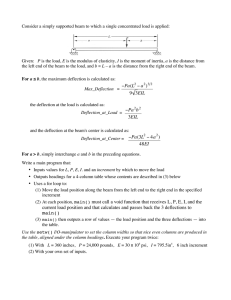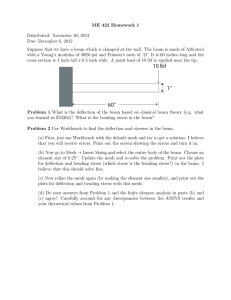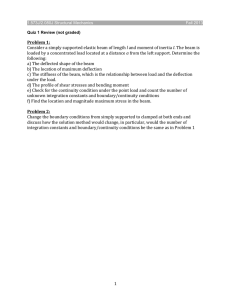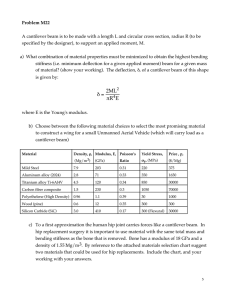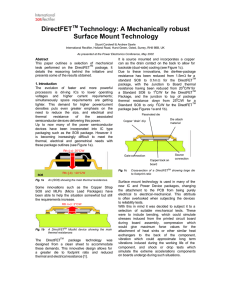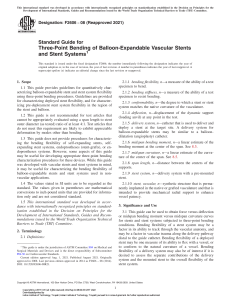Structures - Class Exercise 1a. 1.101 Sophomore Design - Fall 2006 Q d
advertisement
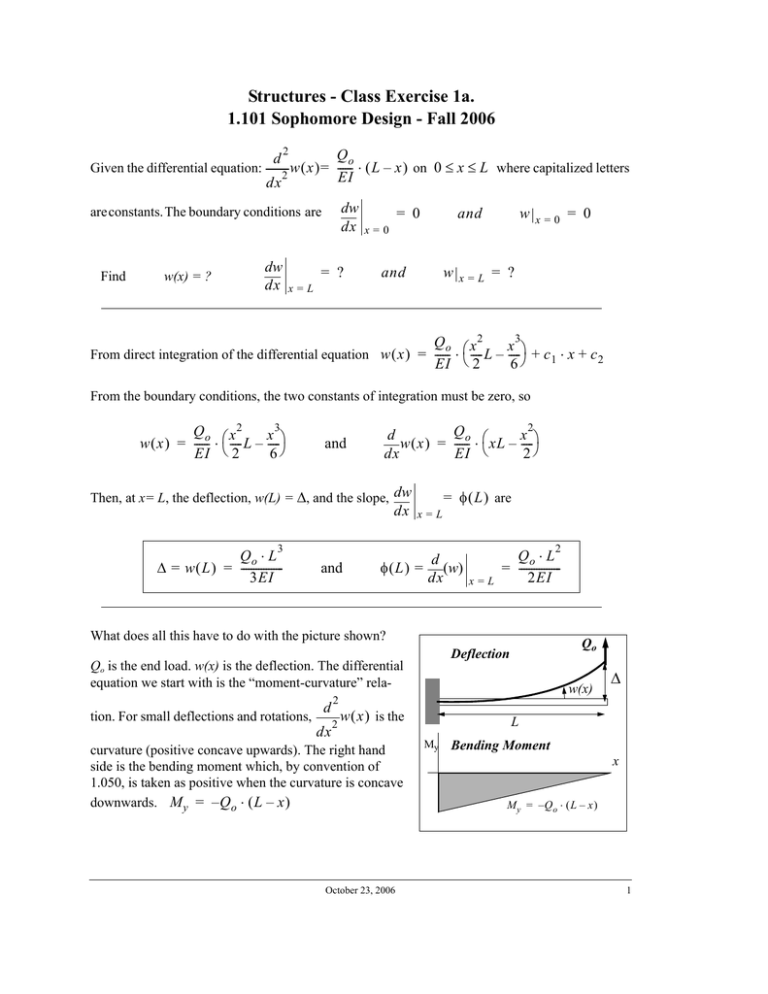
Structures - Class Exercise 1a. 1.101 Sophomore Design - Fall 2006 Given the differential equation: 2 Qo w ( x ) = ------ ⋅ ( L – x) on 0 ≤ x ≤ L where capitalized letters 2 EI dx d dw dx are constants. The boundary conditions are Find w(x) = ? dw dx = ? = 0 and w x=0 = 0 x=0 and w x=L = ? x=L Qo 2 3 From direct integration of the differential equation w ( x ) = ------ ⋅ ⎛ -----L – -----⎞ + c 1 ⋅ x + c 2 EI ⎝ 2 6⎠ x x From the boundary conditions, the two constants of integration must be zero, so 3 Qo ⎛ x2 x ⎞ w ( x ) = ------ ⋅ -----L – ----EI ⎝ 2 6⎠ and 2 Qo ⎛ d x ⎞ w ( x ) = ----- ⋅ xL – ----dx EI ⎝ 2⎠ Then, at x= L, the deflection, w(L) = ∆, and the slope, dw dx 3 Qo ⋅ L ∆ = w( L ) = ----------------3EI and = φ ( L ) are x=L d φ ( L ) = (w) dx 2 x=L Qo ⋅ L = ---------------2EI What does all this have to do with the picture shown? Qo is the end load. w(x) is the deflection. The differential equation we start with is the “moment-curvature” rela tion. For small deflections and rotations, d dx 2 2 w(x) w ( x ) is the curvature (positive concave upwards). The right hand side is the bending moment which, by convention of 1.050, is taken as positive when the curvature is concave downwards. M y = –Q o ⋅ ( L – x) October 23, 2006 Qo Deflection ∆ L My Bending Moment x M y = –Q o ⋅ ( L – x) 1 Structures - Class Exercise 1b. 1.101 Sophomore Design - Fall 2006 2 –M o w ( x ) = ---------2 EI dx d Given the differential equation: letters are constants. The boundary conditions are Find w(x) = ? dw dx = ? on 0 ≤ x ≤ L where all capitalized dw dx = 0 w x=0 = 0 x=0 and w x=L = ? x=L As in the previous exercise, we find, after applying the boundary conditions 2 –M o x w ( x ) = ---------------2EI –M o x d w ( x ) = -----------dx EI and Then, at x= L, the deflection, w(L) = ∆, and the slope, dw dx = φ ( L ) are x=L 2 –M o L ∆ = w ( L ) = ---------------2EI and φ(L) = d (w) dx x=L –M o L = ------------EI What does all this have to do with the picture shown? Deflection Here, Mo is the applied moment at the end of the beam. Within the beam, 0<x<L, the bending moment is con stant and equal to the applied moment. It is positive according to our convention. L w(x) ∆ My My = Mo Bending Moment Mo x We now superimpose these two loading cases to solve a more general problem and one that is rel evant to your design task. October 23, 2006 2 For the cantilever under end load and end moment, the deflected shape might look as shown . Qo w(x) ∆ φ<0 Mo L For this combined loading, we have: 2 3 Qo ⎛ x2 x ⎞ –M o x w ( x ) = ------ ⋅ -----L – ----- + --------------EI ⎝ 2 6⎠ 2EI 2 Qo ⎛ d x ⎞ –M o x w ( x ) = ------ ⋅ xL – ----- + -----------dx EI ⎝ 2⎠ EI At the end of the beam, we have: 3 2 Qo ⋅ L Mo L ∆ = ----------------- –------------3EI 2EI 2 Qo ⋅ L Mo L φ ( L ) = ---------------- – ---------2EI EI and We want the solution for the special case when the slope at x = L is zero. Qo w(x) Mo φ=0 ∆ L Qo ⋅ L = ------------Setting φ(L) = 0 gives the applied end moment in terms of the end force M o 2 φ(L) = 0 3 Qo ⋅ L So, in this case, the tip deflection is ∆ = ----------------- or, expressing Qo in terms of the displacement, 12EI Qo = K ⋅ ∆ where the stiffness, K, is October 23, 2006 12 ⋅ EI K = --------------3 L 3 Engineering Beam Theory Engineering beam theory shows that the most significant stress is the normal stress component on an “x face”; σx in the example at the right. It is related to the applied loads by z σ x , εx L P z, w(x) a where z is the distance from the “neutral axis” which, for a doubly symmetric beam, is at the center of the cross-section and I is the moment of inertia of the cross section. ∫z 2 dA P a x z My. A My x My ⋅ z σ x = -------------I I = Qz For a rectangular cross-section of width b and height h, this is I = bh3/12 My. R The applied loads come in through the bend ing moment My. The convention for positive shear and bending moment is shown in the figure. The extensional strain, from the stress/strain relations is just ε x = σ x ⁄ E where E is the Elastic Modulus. In terms of the geometry of deformation, the extensional strain is given by ε x = z ⁄ R where R is the radius of curvature of the neutral axis. (1/R) is the curvature. The “bending stiffness” is defined as the product E I as it appears in the “moment-curvature” relationship M y = ( EI ) ⋅ ⎛ -- ⎞ ⎝ R⎠ 1 where the curvature, for small deflections, is related to the vertical displacement of the neutral axis by, (1/R) = - d2w/dx2 or . – M y ⁄ ( EI ) = d 2 2 w(x) dx An integration of the differential equation obtained from the moment curvature relation gives, for the case where the beam is loaded as shown, the mid-span deflection w midspan Pa 2 2 = – ⎛⎝ ------------⎞⎠ ⋅ ( 3L – 4a ) 24EI October 23, 2006 4

